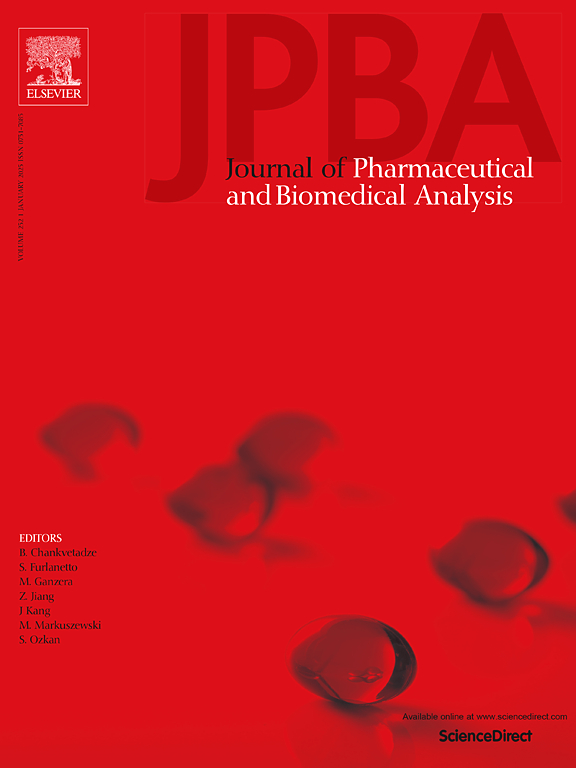雄性Wistar大鼠肝毒素甲嘧啶的血浆和尿液代谢谱的研究
IF 3.1
3区 医学
Q2 CHEMISTRY, ANALYTICAL
Journal of pharmaceutical and biomedical analysis
Pub Date : 2025-05-21
DOI:10.1016/j.jpba.2025.116976
引用次数: 0
摘要
研究了2-噻吩基h1受体拮抗剂甲基吡啶(N,N-二甲基-N'-吡啶-2-基-N'-(噻吩-2-基甲基)乙烷-1,2-二胺)在大鼠中口服0、50或150 mg/kg/天5天后的血浆和尿液代谢物谱。首先使用快速“适合用途”的反相(RP) UHPLC-MS/MS法研究了甲基嘧啶的全身暴露和代谢命运,然后使用RP- uhplc和高分辨率多反射飞行时间质谱仪对其代谢产物进行了更深入的表征。在给药后24 h获得的样品中,在第1、3和5天的任何剂量下,血浆中均未检测到甲基嘧啶。然而,在研究的第3天和第5天,在这些血浆样本中检测到甲基吡啶衍生代谢物的数量越来越多。在第3天和第5天给药后24 h收集的尿液中均存在甲基吡啶和大量代谢物。这些代谢物的谱是剂量和时间依赖的。通过使用+ve和-ve ESI HRMS获得的尿液和血浆谱,表征了24种代谢物的功能化,包括脂肪和芳香羟基化、n -氧化、n -去甲基化和噻吩环的丢失。葡萄糖醛酸、甘氨酸和谷胱甘肽衍生的缀合物也被检测到。本文章由计算机程序翻译,如有差异,请以英文原文为准。
An investigation of the plasma and urinary metabolite profiles of the hepatotoxin methapyrilene in the male Wistar rat
The plasma and urinary metabolite profiles of the 2-thiophene-based H1-receptor antagonist methapyrilene (N,N-dimethyl-N'-pyridin-2-yl-N'-(thiophen-2-ylmethyl)ethane-1,2-diamine) were investigated in the rat following the oral administration of 0, 50 or 150 mg/kg/day of the drug for 5 days. The systemic exposure and metabolic fate of methapyrilene were investigated initially using a rapid “fit for purpose” reversed-phase (RP) UHPLC-MS/MS assay followed by a more in-depth characterization of its metabolites using RP-UHPLC coupled to a high resolution multi reflecting time of flight mass spectrometer. No detectable methapyrilene was present in plasma when measured on days 1, 3 and 5, at any dose, using samples obtained 24 h post administration. However, methapyrilene-derived metabolites were detected, in increasing amounts, in these plasma samples on days 3 and 5 of the study. Both methapyrilene and large numbers of metabolites were present in the urines collected 24 h after dosing on days 3 and 5. The profiles of these metabolites were both dose and time dependent. From the urine and plasma profiles obtained using both +ve and -ve ESI HRMS some 24 metabolites were characterized showing functionalization by aliphatic and aromatic hydroxylation, N-oxidation, N-demethylation and loss of the thiophene ring. Glucuronic acid, glycine and glutathione-derived conjugates were also detected.
求助全文
通过发布文献求助,成功后即可免费获取论文全文。
去求助
来源期刊
CiteScore
6.70
自引率
5.90%
发文量
588
审稿时长
37 days
期刊介绍:
This journal is an international medium directed towards the needs of academic, clinical, government and industrial analysis by publishing original research reports and critical reviews on pharmaceutical and biomedical analysis. It covers the interdisciplinary aspects of analysis in the pharmaceutical, biomedical and clinical sciences, including developments in analytical methodology, instrumentation, computation and interpretation. Submissions on novel applications focusing on drug purity and stability studies, pharmacokinetics, therapeutic monitoring, metabolic profiling; drug-related aspects of analytical biochemistry and forensic toxicology; quality assurance in the pharmaceutical industry are also welcome.
Studies from areas of well established and poorly selective methods, such as UV-VIS spectrophotometry (including derivative and multi-wavelength measurements), basic electroanalytical (potentiometric, polarographic and voltammetric) methods, fluorimetry, flow-injection analysis, etc. are accepted for publication in exceptional cases only, if a unique and substantial advantage over presently known systems is demonstrated. The same applies to the assay of simple drug formulations by any kind of methods and the determination of drugs in biological samples based merely on spiked samples. Drug purity/stability studies should contain information on the structure elucidation of the impurities/degradants.

 求助内容:
求助内容: 应助结果提醒方式:
应助结果提醒方式:


